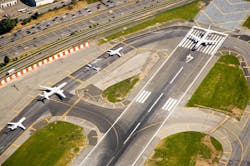WASHINGTON - The Federal Aviation Administration (FAA) announced it is launching a new surface safety tool, called Approach Runway Verification (ARV), at air traffic control towers across the nation to improve safety at airports. Austin-Bergstrom International Airport is the latest tower to start using the safety technology.
ARV furnishes controllers with both visual and audible warnings if an incoming aircraft appears to be aligned to land on an incorrect part of the airport surface or even at the wrong airport altogether.
As aircraft approach the airport, controllers issue landing clearances for specific runways. Despite pilots believing they are aligned with the correct runway, they might unintentionally line up with an adjacent runway or a taxiway. ARV promptly notifies the controller if the aircraft's alignment doesn't match the instructed runway surface.
Related: Airline close calls happen far more often than previously known
ARV constitutes one of the three solutions for surface situational awareness within the FAA's expedited surface safety portfolio. The other components include the Runway Incursion Device (RID) and the Surface Awareness Initiative (SAI). These technologies are characterized by agility, efficiency, and cost-effectiveness.
RID serves as an aid for controllers, offering supplementary situational awareness regarding occupied or closed runways. It provides controllers with both audible and visual alerts when a runway is unavailable for aircraft departures or landings.
The FAA says SAI harnesses cost-effective, commercially available technologies to exhibit surface traffic to controllers at airports lacking a dedicated surface surveillance tool.
Related: FAA issues industrywide call to action following runway close calls
"A safe National Airspace System is fundamentally dependent on the airport surface," remarked FAA Administrator Mike Whitaker. "Equipping controllers with resources like Approach Runway Verification enhances their awareness of the airport surface, which is critical for advancing safety."
ARV is currently installed at several air traffic control towers including Austin, Lincoln Tower, Elton Hensley, Lansing, DuPage, Chicago Executive, Tallahassee, Cedar Rapids, Branson West Municipal, Gerald Ford International, Elkhart Municipal, South Bend, and M. Graham Clark Downtown Airport.



